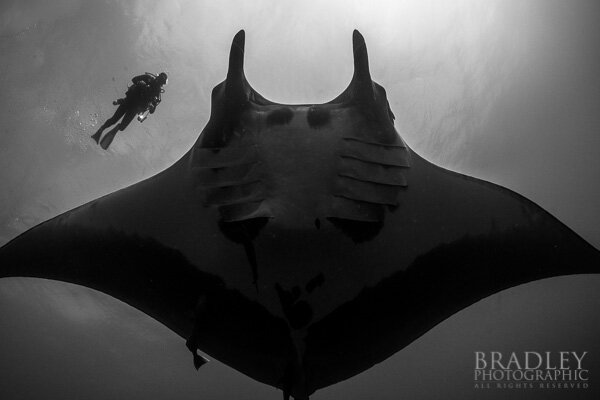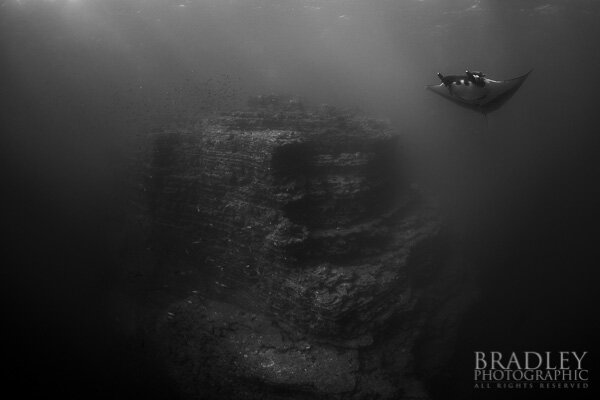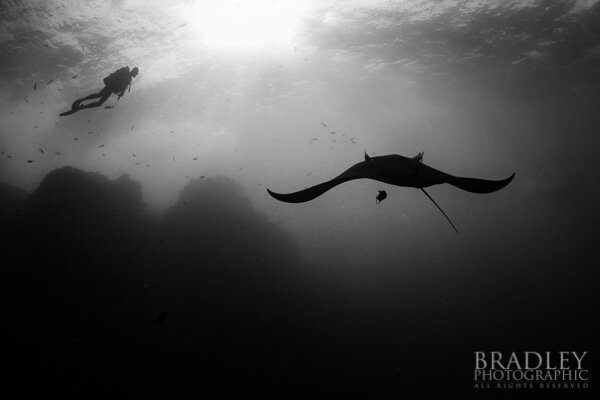Nature Reaching Back
As a photographer I often find myself, with camera in hand, reaching into nature in hopes of finding something compelling, thought provoking, and beautiful. Sometimes I get lucky enough to find myself in a place where nature reaches back, and las Islas Revillagigedo is most definitely such a place.
A black manta quietly glides toward a reef and diver at the dive site Cabo Pearce, San Benedicto Island.
I recently had the privilege to lead a small group of photographers to Revillagigedo, which is a small archipelago in – it’s safe to say – the middle of nowhere. Getting to this remote place known to scuba divers as Socorro (after the largest island of the group) is no easy task. First we flew into San Jose del Cabo (the airport closest to Cabo San Lucas), which is found at the southern tip of Baja California. From there we boarded our vessel, the Nautilus Belle Amie, and began our trek 290 miles into the blue of the map. Cruising just shy of 10 knots, it took us about 36 to reach our destination.
The first island we visited at was San Benedicto. The goal was to dive a place known as The Canyon, but as luck would have it, we were not the only dive boat in the middle of nowhere. But worry I did not, as the first dive is usually reserved less for adventure and more for checking out gear and making sure our weight is trimmed out the way we want it, so off to a second first-dive spot…
Our first dive turned out to be at El Fondeadero where we saw almost nothing. Mostly we swam through a lot of blue water where the visibility was good, but without much to see other than rocks and patterns in the sand. Just before my dive was over I did see something. About 30 feet or more over my head and off in the distance I caught a glimpse of the ghostly shape of a giant manta ray. Only three of us divers got lucky enough to see the manta, and the pass was brief.
A silhouette of a giant manta ray at San Benedicto Island, Mexico.
Giant Mantas are one of the highlights of visiting Socorro and they are impressive. From wing tip to wing tip they can be over 20 feet wide and they glide effortlessly through the water. Few animals are as beautiful and memorizing as the manta.
With the exception of that brief manta interaction at El Fondeadero, we spent the next several dives bouncing from site to site only to find more rocks and more sand in between. I was honestly starting to get worried, and my expectations were getting low, fast.
The Belle Amie’s captain, Bryden, aware of our discouraged faces, decided to take us to a site called The Boiler, which he knew was a place that consistently delivered manta encounters. The Boiler is made of two underwater pinnacles just off shore that are aptly named Big Boiler and Little Boiler. The top of Big Boiler lies just under the water’s surface and, when the tide and swell are right, waves crash on top and the water churns and “boils.” Of course, the dive masters instructed us to keep clear of this zone — it gets very dangerous.
Think of The Boiler as an underwater spa for manta rays. Some of you may have heard of, or even been to, these spas where you put your feet into a water tank filled with little cleaner fish that begin nibbling at your feet, cleaning them. Well, such spas are found naturally all through the world’s oceans, and The Boiler is such a place. Manta Rays come here and the cleaner fish quickly jump on their backs, under their bellies, and on their heads, and they start pecking away at the mantas. But the mantas have also learned that this “spa” has a built-in Jacuzzi (kind of).
As divers swim around The Boiler they do what they do—blow bubbles. The mantas seem to love the bubbles. They swim through them, over them, into them, and often will stop to hover over a diver that knows how to give good bubbles. After a few dives I noticed a pattern in behavior with some of the mantas. Sometimes a manta would swim up to a diver, stop in front of the diver and turn their body to a 45º angle and shake their wings, as if saying, “I’m ready for your bubbles.” It truly felt like they were communicating.
Needless to say, I have no idea what the mantas are thinking. I don’t know if they are experiencing joy as we do, or if they are speaking to us, or what is truly motivating them. But I do know that the mantas can leave at any time. They do not have to stay. They don’t have to interact with us. Yet they choose to do so. In fact, they choose to continually circle us over and over again, swimming through our bubbles and exhibiting behavior that’s hard to interpret as anything other than interested. Whatever their motivation, I always feel privileged when wild things reach out to interact with us. Usually it’s the other way around.







